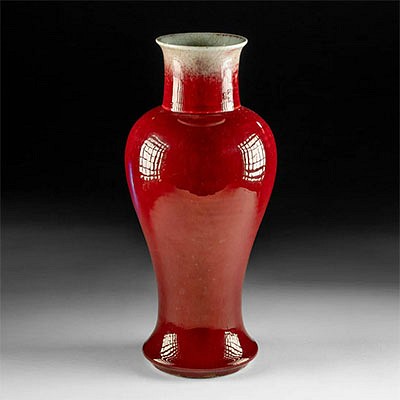Rare Sican / Chimu Gold Tumi Scepter w/ Jaguars
Lot 271
About Seller
Artemis Fine Arts
686 S Taylor Ave, Ste 106
Louisville, CO 80027
United States
Selling antiquities, ancient and ethnographic art online since 1993, Artemis Gallery specializes in Classical Antiquities (Egyptian, Greek, Roman, Near Eastern), Asian, Pre-Columbian, African / Tribal / Oceanographic art. Our extensive inventory includes pottery, stone, metal, wood, glass and textil...Read more
Categories
Estimate:
$9,000 - $13,500
Absentee vs Live bid
Two ways to bid:
- Leave a max absentee bid and the platform will bid on your behalf up to your maximum bid during the live auction.
- Bid live during the auction and your bids will be submitted real-time to the auctioneer.
Bid Increments
| Price | Bid Increment |
|---|---|
| $0 | $25 |
| $300 | $50 |
| $1,000 | $100 |
| $2,000 | $250 |
| $5,000 | $500 |
| $10,000 | $1,000 |
| $20,000 | $2,500 |
| $50,000 | $5,000 |
| $100,000 | $10,000 |
| $200,000 | $20,000 |
About Auction
By Artemis Fine Arts
May 11, 2023
Set Reminder
2023-05-11 10:00:00
2023-05-11 10:00:00
America/New_York
Bidsquare
Bidsquare : Fine Antiquities, Asian, Pre-Columbian, Ethnographic Art
https://www.bidsquare.com/auctions/artemis-gallery/fine-antiquities-asian-pre-columbian-ethnographic-art-12771
Classical antiquities, ancient and ethnographic art from cultures encompassing the globe. Artemis Fine Arts info@artemisgallery.com
Classical antiquities, ancient and ethnographic art from cultures encompassing the globe. Artemis Fine Arts info@artemisgallery.com
- Lot Description
**Originally Listed At $5000**
Pre-Columbian, Central Coast Peru, Sican / Lambayeque to Chimu culture, ca. 700 to 1100 CE. A superb example of a ceremonial tumi scepter shaped from a sheet of 53.8% to 55.5% gold (equivalent to 12K+), 39 to 41.1% silver, and 4% to 5% copper. The blade-shaped tumi body is straight and malleable and is topped by a pair of abstract figures. The seated figures, perhaps representing Naylamp, the traditional founder of the Lambayeque Dynasty, each hold a jaguar by the tail with the creatures' bodies inverted, and above is an enormous, crescent-shaped tumi blade with impressed edges. Two conical ornaments with spherical upper elements are suspended by wires from the outermost corner of the tumi blade and imbue the artifact with a delicate opulence. Size (tumi): 2.7" W x 8.1" H (6.9 cm x 20.6 cm); metal quality: 53.8% to 55.5% gold (equivalent to 12K+), 39% to 41.1% silver, and 4% to 5% copper; total weight: 40.5 grams; (display case): 4" L x 4.1" W x 10.4" H (10.2 cm x 10.4 cm x 26.4 cm)
The figures probably represent Naylamp (also Naymlap, Nanlap, or Nylamp), the traditional founder of the Lambayeque dynasty believed to have come from the south by sea to colonize the region before he allegedly sprouted wings and flew off into the sunset in a dramatic display of his magical powers.
Sican elites were patrons of workshops that made fine metal objects like this tumi and its danglers, and they took their wealth with them when they passed away. Buried in mounds, these individuals would be entombed in high style.
Provenance: private Hawaii collection, acquired 2000 to 2010
All items legal to buy/sell under U.S. Statute covering cultural patrimony Code 2600, CHAPTER 14, and are guaranteed to be as described or your money back.
A Certificate of Authenticity will accompany all winning bids.
We ship worldwide and handle all shipping in-house for your convenience.
#177491Tumi body possibly reattached to top of blade body with resurfacing along break lines. Slight bending to overall form of openwork tumi and blade body, with light abrasions, softening to some finer details, and some light earthen deposits, otherwise in excellent condition. Wonderful patina throughout.Condition
- Shipping Info
-
All shipping is handled in-house for your convenience. Your invoice from Artemis Gallery will include shipping calculation instructions. If in doubt, please inquire BEFORE bidding for estimated shipping costs for individual items. In most cases Artemis Gallery cannot ship to Australia and Germany, please inquire before bidding.
-
- Buyer's Premium



 EUR
EUR CAD
CAD AUD
AUD GBP
GBP MXN
MXN HKD
HKD CNY
CNY MYR
MYR SEK
SEK SGD
SGD CHF
CHF THB
THB














